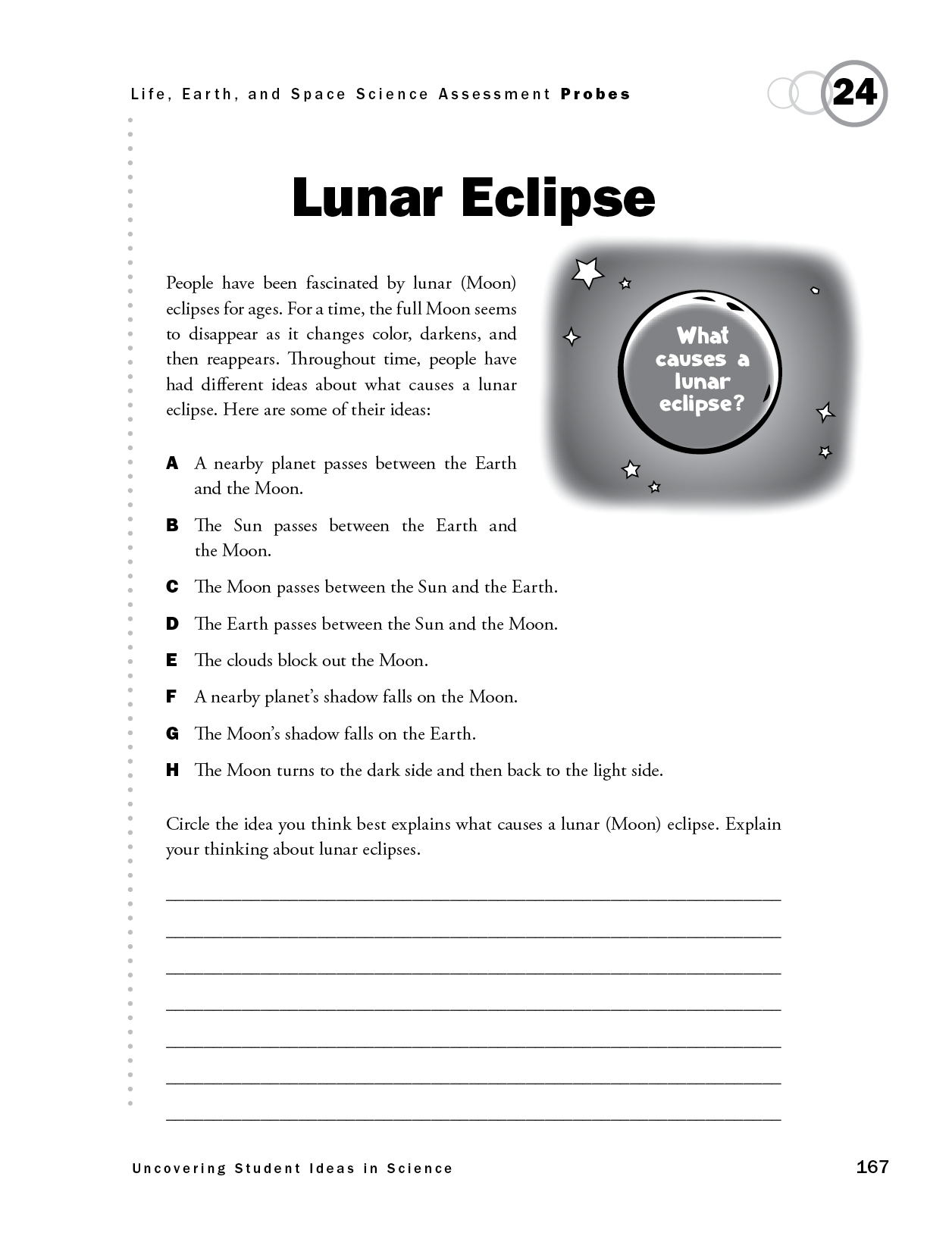Middle School | Formative Assessment Probe
Lunar Eclipse
By Page Keeley
Assessment Earth & Space Science Middle School
Sensemaking Checklist




This is the new updated edition of the first book in the bestselling Uncovering Student Ideas in Science series. Like the first edition of volume 1, this book helps pinpoint what your students know (or think they know) so you can monitor their learning and adjust your teaching accordingly. Loaded with classroom-friendly features you can use immediately, the book includes 25 “probes”—brief, easily administered formative assessments designed to understand your students’ thinking about 60 core science concepts.

Purpose
The purpose of this assessment probe is to elicit students’ ideas about eclipses. The probe is designed to find out what students think causes a lunar eclipse.
Type of Probe
Sequencing
Related Concepts
lunar eclipse
Explanation
The best answer is D: The Earth passes between the Sun and the Moon. A lunar eclipse occurs whenever the Moon passes through some portion of the Earth’s shadow. This occurs when the Sun, Earth, and Moon are in very close alignment, with the Earth in the middle. There is always a full Moon the night of a lunar eclipse. You will usually see a bright lunar disk gradually turn dark as it passes through Earth’s shadow—sometimes a coppery red color—for as long as an hour or more during a total eclipse. The Earth’s shadow has two parts, called the penumbra and the umbra. The umbra is much darker than the penumbra. When the entire Moon passes through the umbra, it is called a total lunar eclipse. When only part of the Moon passes through the umbra, it is called a partial lunar eclipse. And when the Moon goes through the penumbra, it is called a penumbral eclipse. In each of these types of eclipses, the Earth is always between the Sun and the Moon. Lunar eclipses (as well as solar eclipses) happen roughly every six months. A lunar eclipse is visible to anyone on Earth who would have otherwise seen the full Moon.
Curricular and Instructional Considerations
Elementary Students
In the elementary grades, students learn basic ideas about the Moon, including the fact that the Moon can be seen in the daytime and that it changes each day in a pattern that lasts about a month. Explanations for Earth, Moon, and Sun phenomena, such as phases of the Moon and eclipses, should be observational at this age, not explanatory.
Middle School Students
In the middle grades, students develop a more sophisticated understanding of the Earth, Moon, and Sun system, including explanations for the phases of the Moon and eclipses. At this grade level, they should be able to compare and contrast the difference between a lunar and solar eclipse as well as the difference between what causes a lunar eclipse versus the phases of the Moon. The use of models at this grade level is very important for developing an understanding of Earth-Moon-Sun phenomena.
High School Students
Students at the high school level expand their understanding of lunar eclipses to explain the different types of lunar eclipses, depending on where the Moon is in relation to the Earth’s shadow. Their increased understanding of spatial geometry helps them visualize the conditions that must be in place in order for an eclipse to occur. However, many high school students are still confused by Earth-Moon-Sun phenomena like eclipses and phases of the Moon.
Administering the Probe
Ask students if they have ever experienced a lunar eclipse. Consider showing a photograph of a lunar eclipse from the internet or other source when using this probe, as long as it doesn’t clue students as to the correct answer.
Related Research
- Phases of the Moon are often explained using the idea of a shadow of the Earth cast on the Moon, thus confusing eclipse phenomena with Moon phases (Driver et al. 1994).
- Astronomical phenomena are very challenging for students. To understand these phenomena, students must first understand how the Moon gets its light from the Sun as well as understand motion and position in the Earth-Moon-Sun system (AAAS 1993).
Related NSTA Resources
Association for the Advancement of Science (AAAS). 2001. Atlas of science literacy. Vol. 1. (See “The Solar System,” pp. 44–45.) Washington, DC: AAAS.
Gilbert, S., and S. Ireton. 2003. Understanding models in Earth and space science. Arlington, VA: NSTA Press.
National Science Teachers Association (NSTA). 2008. Earth, Sun, and Moon. NSTA SciGuide. Online: http:/learningcenter.nsta.org/product_detail. aspx?id=10.2505/6/SCP-ESM.0.1
Suggestions for Instruction and Assessment
- A lunar eclipse is a phenomenon that is best explained and understood using physical models. However, merely observing a model demonstrated by the teacher is less effective in building understanding than having students manipulate their own models. It is important that students have opportunities to make and use their own models to understand eclipse phenomena.
- Have students use their models to compare and contrast a lunar eclipse with a new Moon. Comparing the two phenomena can be helpful in challenging their preconceptions about both events.
- Google NASA websites to find data on and activities related to lunar eclipses. There are many websites developed for education that target eclipse ideas.
- The PRISMS (Phenomena and Representations for Instruction of Science in Middle Schools) website, an NSDL (National Science Digital Library) resource, maintains a collection of reviewed lunar eclipse phenomena and representations teachers can use for instructional purposes. To access this collection, go to http://prisms.mmsa.org.


